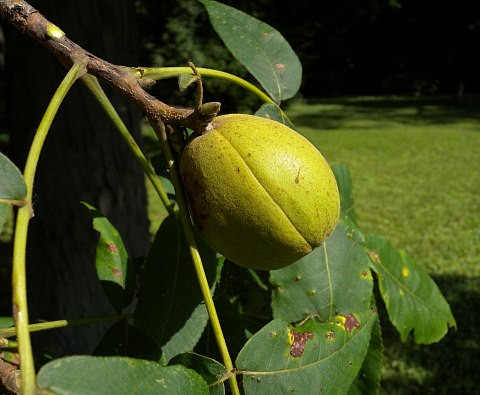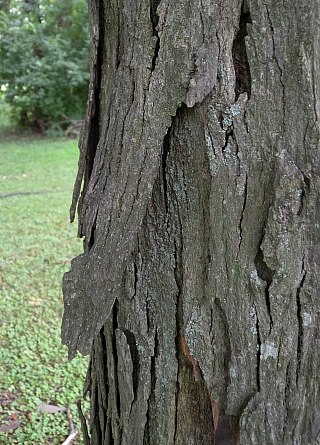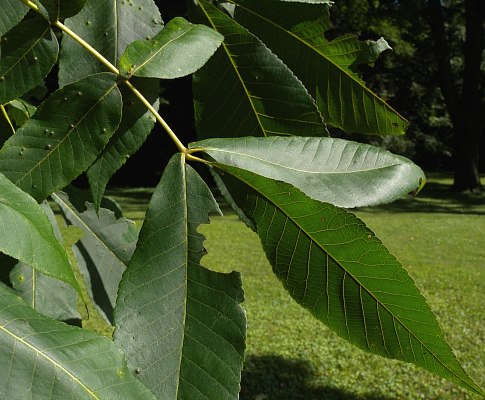Description: This deciduous tree is 60-100' tall at maturity, forming a tall straight trunk and an ovoid to oblongoid crown. The lower branches have a tendency to droop. The trunk bark of mature trees is gray and shaggy; the shaggy appearance is caused by sheets of bark that peel away partially from the trunk. The bark of branches is gray and rough-textured, while young twigs are pale to medium brown with orange lenticels. Early in the season, young twigs are hairy, but they become glabrous later in the year. Alternate compound leaves up to 2¼' long and 1' across occur along the twigs and small branches. These compound leaves are odd-pinnate with 5-9 leaflets (see Leaf Photo); they have light green petioles about 3-6" long that often persist on the tree during the winter after the leaflets have fallen to the ground. Individual leaflets are 3-6" long and 1-2½" across; terminal leaflets are usually larger in size than proximal leaflets (those located closest to the petioles). The leaflets are lanceolate, elliptic, oblanceolate, ovate, or obovate in shape and their margins are serrated. The terminal leaflet has a short petiolule, while the lateral leaflets are sessile or nearly so. The upper surface of each leaflet is medium to dark green and glabrous, while the lower surface is pale green and short-pubescent; this pubescence persists throughout the growing season. Quite often, there are also tiny pale hairs along the outer margins of the teeth, although not at the tips of the teeth.

Like other hickories, Kingnut Hickory is monoecious, producing separate staminate (male) and pistillate flowers (female) on the same tree. The staminate florets are arranged in groups of 3 drooping catkins from the tips of short branches; these catkins are about 3-6" long and narrowly cylindrical. Individual staminate flowers have a short green calyx with 2-4 narrow lobes and 3-10 stamens with short filaments. Directly underneath the calyx, there is a green hairy bracteole with long narrow lobes that partially obscure the staminate floret from view. The pistillate florets are produced in small clusters of 2-6 from the same twigs as the catkins. Each pistillate floret has a short green calyx with 4 lobes and a pistil with 2-4 exerted styles. The pistillate florets can be cross-pollinated by the wind, although they are also self-fertile to some extent. The blooming period occurs from mid- to late spring before the leaves develop. Fertile pistillate florets develop into ovoid-globoid fruits about 1¾–2½" long and 1½–2" across. Each fruit consists of a nut that is surrounded a thick husk. The husk is divided into 4 segments; it is relatively flat along the linear divisions between the segments, rather than indented. The outer surface of an immature husk is green, but it become dark brown at maturity. Each nut is ovoid, slightly 4-angled, and slightly flattened in shape; its shell is light brown, smooth, and thick. The nut meat is sweet and edible. The root system consists of a deep taproot with smaller lateral roots. This tree reproduces by reseeding itself.

Cultivation: The preference is partial to full sun, moist conditions, and soil consisting of deep loam or silt. Saplings tolerate light shade underneath taller trees. Temporary flooding is tolerated during the spring. The nuts germinate in moist soil during the late spring after they have been exposed to 90-120 days of winter cold. Above-ground growth and development is rather slow. Nuts are not produced until a tree becomes 40 years old.
Range & Habitat: The native Kingnut Hickory is found in the southern two-thirds of Illinois (see Distribution Map). Depending on the area, it is occasional to rare. Habitats consist of bottomland woodlands, upland woodlands, swamps, savannas, and limestone glades. This tree is most often found in bottomland deciduous woodlands in areas that are not far from rivers. It associates with other deciduous trees that prefer this kind of habitat, including Red Maple, Silver Maple, American Basswood, various Elms, and Green Ash.
Faunal Associations: Kingnut Hickory and other hickory trees (Carya spp.) attract a large number of insects, for whom they provide food and protective cover. Insect feeders include the caterpillars of Actias luna (Luna Moth) and other moths, caterpillars of the butterflies, Satyrium calanus (Banded Hairstreak) and Satyrium caryaevorum (Hickory Hairstreak), wood-boring larvae of the Hickory Agrilus (Agrilus otiosus) and wood-boring larvae of many long-horned beetles (Cerambycidae), leaf beetles (Chrysomelidae), weevils (Conotrachelus spp. & others), aphids (Monellia spp., Monelliopsis spp., Myzocallis spp., & others), treehoppers (Membracidae), leafhoppers (Eratoneura spp.), the Hickory Scurfy Scale (Chionaspis caryae) and other armored scales, plant bugs (Phytocoris spp. & others), and larvae of gall flies (Caryomyia spp. & others). See the Insect Table for a more complete list of insects that feed on hickory trees. Several species of insectivorous birds forage for these insects on Kingnut Hickory and other hickory trees. These species include the Scarlet Tanager, Summer Tanager, Tufted Titmouse, Carolina Chickadee, Northern Parula, Cerulean Warbler, Yellow-throated Warbler, Yellow-billed Cuckoo, Blue-gray Gnatcatcher, Acadian Flycatcher, Yellow-throated Vireo, and Red-eyed Vireo (Gabbe et al., 2002). Hickory nuts are an important source of food for many mammals. This includes such species as tree squirrels (Gray Squirrel, Fox Squirrel, Southern Flying Squirrel), Eastern Chipmunk, American Black Bear, Raccoon, Gray Fox, and White-footed Mouse. Birds that feed on hickory nuts include the Wood Duck, Red-bellied Woodpecker, Wild Turkey, Ring-necked Pheasant, Bobwhite Quail, Blue Jay, American Crow, and White-breasted Nuthatch (Martin et al., 1951/1961). Tree squirrels and chipmunks can carry the nuts for some distance, and often bury them in the soil for possible retrieval later. Because they sometimes forget to retrieve such buried nuts (or die before they are retrieved), these animals help to spread hickory trees into new areas. Tree squirrels use the cavities of such trees as a place of sanctuary for themselves and their young. The endangered Indiana Bat (Myosotis sodalis) uses the crevices of peeling bark as summer roost sites during the day. The Evening Bat (Nycticeius humeralis) roosts in both the interior cavities and the crevices of peeling bark of these trees (MuÌnzer, 2008).

Photographic Location: Edge of a cemetery not far from a river in Urbana, Illinois.
Comments: Because it is slow-growing and somewhat messy from the large nuts, large leaves, and peeling bark, Kingnut Hickory is not often used as a landscape tree. This is unfortunate, because its value to wildlife is quite high and it is an attractive tree that resists storm damage. The wood is close-grained, strong, and flexible; it is used in making tool handles and furniture. Kingnut Hickory can be distinguished from other Carya spp. (hickories) by its shaggy bark, compound leaves with 7 leaflets (usually), large-sized fruits (often 2" long or more), and orange-dotted twigs. It is often confused with Carya ovata (Shagbark Hickory), however the latter has compound leaves with 5 leaflets (usually), slightly smaller fruits that are more indented between their husk segments, and twigs that lack orange lenticels. Another common name of Carya laciniosa is Shellbark Hickory.